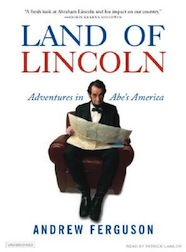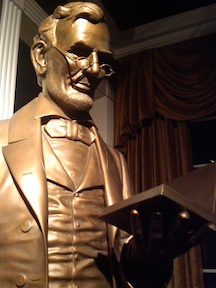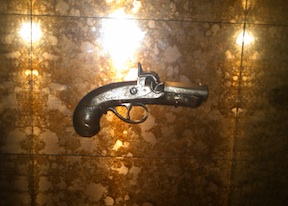The Land of Lincoln and the Defense of the Icon
The Lincoln Memorial looked like frost tonight. The flurry that had blanketed the lawn white earlier in the day had been glazed with rain and then turned to ice, so the whole landscape shimmered under the Memorial’s lights.
Frost or no, the Memorial still has that beacon-in-the-dark look, which is, I suppose, its main purpose. It is, as I’ve noted before, as close to a temple as we have in America. The man who sits inside has become such an icon he’s lost humanity.
 I’m here because I’ve just finished rereading journalist Andrew Ferguson’s Land of Lincoln (2007), an exploration of the man and, in the end, a defense of that icon. I’m here for the icon, too.
I’m here because I’ve just finished rereading journalist Andrew Ferguson’s Land of Lincoln (2007), an exploration of the man and, in the end, a defense of that icon. I’m here for the icon, too.
When Abraham Lincoln died, Secretary of War Edwin Stanton famously said, “Now he belongs to the ages.” More than that, though, Lincoln belongs to all of us—and we can each make him into the person we want him to be.
That’s what journalist Andrew Ferguson sets out to explore in Land of Lincoln. The state of Illinois may claim that as its motto, but Ferguson discovers Lincoln’s presence in the most unexpected of places. “I wanted to know what we know about Lincoln, and I wanted to know how we know it,” he says.

Land of Lincoln chronicles Ferguson’s quest to discover the true Abraham Lincoln—the one who doesn’t belong to the ages, the one who’s not chiseled from granite and sitting vigil in a temple-like memorial, the one who’s not known just for writing “Four score and seven years ago.”
“More books have been written about Abraham Lincoln than about any other American—nearly fourteen thousand in all,” Ferguson writes, “and at least half of those books begin by saying that more books have been written about Abraham Lincoln than any other American. This book, you’ll notice, is one of them.”
Ferguson’s book is simultaneously charming and earnest. It’s hard not to be amused when he hangs out with 175 Lincoln impersonators in Santa Claus, Indiana, during their annual convention. “It began with the beard,” one impersonator explains to Ferguson.
“Talking to other Abes, I discovered that this is how it almost always happens,” Ferguson writes. “A fellow, minding his own business, decides to grow a beard. Soon, multiple people are telling him that he bears a striking resemblance to Abraham Lincoln. It doesn’t matter that very often these people are wrong. So strong is the lure of Lincoln that when people tell a man with a beard that he looks like the greatest of all Americans, he believes it.”
Ferguson goes to Gettysburg to sit in on a leadership institute’s Lincoln-themed training session. (The book Lincoln on Leadership, after all, is one of the best-selling business books of all time.) Gettysburg, he notes, has “a dazed, dull feel to it—the consequence, I suppose, of taking a scene of blood-drenched horror and unspeakable heartbreak and trying to make it a pleasant vacation spot.”
Ferguson travels to the area around Lincoln’s boyhood home where he watches a musical theater production based on the young Lincoln’s life. He visits the Lincoln Presidential Library and Museum in Springfield, Illinois, where Disney “imagineers” created a museum that creates a powerful emotional experience but somehow manages to avoid information. The primary purpose, says Ferguson, is to make Lincoln “fun.”
“Get their hearts and their heads will follow,” the imagineer tells him. “You lead with the emotions rather than the intellect. And remember, it’s not any old emotion—the emotion they feel is the one we want them to feel.”
Ferguson visits historical sites, National Parks, and museums. He examines statues. He follows the old Lincoln Heritage Trail. The Land of Lincoln, Ferguson discovers, exists as much in our national subconscious as it does in any geographical spot. This was useful for me because, like Confederates in the Attic, the book becomes a portrait of a cultural landscape.

The supporting cast proves to be highly colorful. Ferguson meets people cult-like in their devotion to Lincoln. He talks with Lincoln scholars, Lincoln collectors, and even Lincoln critics. “Who could object to Lincoln?” Ferguson asks. “He seems too big even to have an opinion about.” Yet when the National Park Service installed a Lincoln statue at its Civil War battlefield park in Richmond, commemorating a visit Lincoln made to the city in April 1865 when the city surrendered, controversy erupted.
Throughout, Ferguson continues to ask, “Who is Lincoln? Why is he important to us today?” He never draws firm conclusions but instead presents a wide array of evidence for readers to consider—just as he himself considers it, too.
“What if Lincoln the man was, as I’d come to suspect, unknowable, as most men are 140 years after their death?” he writes. “And what if the icon—big, grand, unmistakable—is more real than the much smaller, custom-fit Lincolns that each of us creates for ourselves?”
Serious in its goals but light in its tone, Land of Lincoln successfully weaves together history, travel, cultural studies, and even memoir to sketch a thoughtful portrait of one of America’s most known—and perhaps least knowable—figures. Land of Lincoln doesn’t try to debunk any myths but instead tries to figure out how the man grew into myth. Both have value.
 Ferguson finishes his journey on the steps of Washington, D.C.’s Lincoln Memorial. “It’s the unavoidable Lincoln,” he says. “Anyone who wants to understand the Land of Lincoln has to account for it.”
Ferguson finishes his journey on the steps of Washington, D.C.’s Lincoln Memorial. “It’s the unavoidable Lincoln,” he says. “Anyone who wants to understand the Land of Lincoln has to account for it.”
That’s why I’m here tonight. I’m accounting for it. I come here two or three times a year, in fact, and I always make it a point to see what Lincoln has to teach me.
Juxtaposed against the experience was a stop earlier in the evening at the new Martin Luther King, Jr., Memorial. Prior to that, I’d visited the National Holocaust Museum to see an exhibit on Nazi propaganda. I was chilled to realize that Hitler, King, and Lincoln all really do belong in the same league when it comes to their skill as communicators, although they employed those skills for very different purposes. I’m still, I admit, wrapping my head around that.
To start the day, I visited Ford’s Theatre, a site Ferguson skipped, but a place I wanted to visit so I could see the newly installed exhibits in the theater’s museum and in the new museum across the street adjacent to the Peterson House (the house where Lincoln died). The exhibits are marvelous and thoughtful, but a quote from one exhibit panel in particular jumped out at me. As the Lincolns were getting ready to head to the theater on the evening of April 14, 1865, the president said to his wife:

“Mary, I consider this day, the war, has come to a close … we must both be more cheerful in the future—between the war and the loss of our darling [son] Willie—we have both been very miserable.”
Scholars spend a lot of time trying to find “the real Lincoln,” as Ferguson points out, but here was a simple quote from Lincoln himself that humanized him for me more than any scholar’s work.
I juxtaposed that against the great marble man sitting in the Memorial. It’s useful to see Lincoln as human, but ultimately, his status as an icon is perhaps more important to us—we who live in a cynical age that dismisses heroes and revels in its iconoclasm. If we’re ever to stop our bitterly partisan political bickering, if we’re all to lend a hand “with malice toward none, with charity toward all,” if we all want a good and decent future for our children, then we all need to aspire to be those very best things that America has always stood for.
Lincoln, I think, personifies that. He really does stand like that beacon in the night. We just have to get over ourselves long enough to admit that it’s okay to aspire for values that we’re usually quick to paint as quaint and old-fashioned. We have honest differences about how to achieve those things, but we’ll never figure out solutions if we don’t stop yelling at each other and decide to talk. “Though passion may have strained it must not break our bonds of affection,” Lincoln said in his first inaugural. Hear, hear!
“Maybe that’s why icons are dismissed as unreal these days,” Ferguson said. “Icons aren’t complicated enough for the wised-up world. Nuance fits the times. We can be consumed by nuance, argue about it on TV, blog about it, fill our scholarly monographs with its infinite refractions—even when, like the forest and the trees, our obsession with it obscures the bigger, unarguable facts that are plain in front of us.”
That’s what Lincoln has to say to me tonight: Aspire to be a better person. Aspire to be a better people. Aspire to be a better nation.
Otherwise, “We shall nobly save or meanly lose the last best hope on earth.”
I’d hate for our own cynicism to be the death of us.
————
Cross-posted at Scholars & Rogues.


These are some great thoughts! Thanks for sharing! Its hard sometimes not to make men like Lincoln larger than life, but in reality what he did for America was larger than life and definitely deserves to be exalted as such. The fact that he was so human makes what he did so interesting. It adds color.
As with all icons, it is their humanity that resonates most with me. My favorite Lincoln image is the one of him reading to young Tad, who is cuddled up next to the man he only knew as “Papa.”
I have also grown to like the man who opened himself up wholeheartedly to George Nicolay, John Hay, and Elmer Ellsworth. He trusted those young men with his campaign, his election and, ultimately, the Presidency. It meant the world to them to be “Lincoln’s Men.”